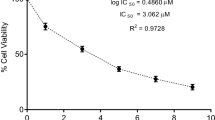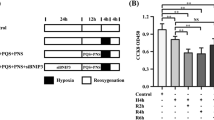Abstract
Background
DSH-20, the active ingredient of Salvia miltiorrhiza flower extract, is used to treat cardiovascular diseases. However, its mechanism of action remains unclear. Herein, we investigated the intervention of DSH-20 in H2O2-induced oxidative damage and apoptosis in cardiomyocytes.
Methods and Results
H2O2 was used to induce oxidative damage and apoptosis in H9c2 cardiomyocytes. Based on concentration gradient studies, we found that 62.5 µg/mL DSH-20 significantly reduced reactive oxygen species and lactate dehydrogenase levels and increased superoxide dismutase levels. DSH-20 also alleviated the apoptosis rate, the changes in mRNA of apoptosis-related genes (Bcl-2, BAX, and Caspase-3) and miR-1 expression. Moreover, transfection of miR-1 mimics aggravated oxidative damage and apoptosis, whereas DSH-20 alleviated these effects.
Conclusions
DSH-20 reduced H2O2-induced oxidative damage and apoptosis in H9c2 cardiomyocytes likely by downregulating miR-1 expression.





Similar content being viewed by others
Data availability
Please contact the authors for data requests.
References
Capodanno D, Alfonso F, Levine G, Valgimigli M, Angiolillo D (2018) ACC/AHA versus esc guidelines on dual antiplatelet therapy: jacc guideline comparison. J Am Coll Cardiol 72:2915–2931
Lamb F, Choi H, Miller M, Stark R (2020) TNFα and reactive oxygen signaling in vascular smooth muscle cells in hypertension and atherosclerosis. Am J Hypertens 33(10):902–913
Khosravi M, Poursaleh A, Ghasempour G, Farhad S, Najafi M (2019) The effects of oxidative stress on the development of atherosclerosis. Biol Chem 400:711–732
Simon A, Vijayakumar T (2013) Molecular studies on coronary artery disease—a review. Indian J Clin Biochem IJCB 28:215–226
Hattiholi J, Gaude G (2014) Prevalence and correlates of osteoporosis in chronic obstructive pulmonary disease patients in india. Lung India 31:221–227
Enzhong X, Huiting L, Chunli L (2019) Influence of modified danshen drink and ticagrelor on cardiac function,hs-crp,nt-probnp and fib of coronary heart disease. West J Tradit Chin Med 32:83–85
Yansheng K, Jingjing L, Wei Z et al (2020) Effect of compound danshen granules, capsules, tablets, and drop pills on curative effect, inflammatory factors, and oxidative stress indexes of angina pectoris patients with coronary heart disease. Drug Eval Res 43:287–292
Baolu Z, Jiang W, Yan Z, Jingwu H, Wenjuan X (1996) Scavenging effects of salvia miltiorrhiza on free radicals and its protection for myocardial mitochondrial membranes from ischemia-reperfusion injury. Biochem Mol Biol Int 38:1171–1182
Lingpeng M, Yi S, Wei C (2019) Research progress of salvia miltiorrhiza and its active ingredients on myocardial protection of sepsis. J Emerg Tradit Chin Med 28:2242–2245
Baohong H (2020) Clinical effect of Tanshinone IIA sodium sulfonate combined with aspirin and clopidogrel in the treatment of patients with acute coronary syndrome. Chin Remedies Clin 20:1483–1485
Lin T, Zongbao L, Ruina B (2020) Protective effect of Tanshinone IIA on ox-ldl-induced vascular endothelial injury on ox-ldl-induced vascular endothelial injury. China Pharm 29:63–66
Mengjiao W, Bing Z (2018) Research progress of salvianolic acid a in the treatment of ischemic stroke. Modern Med J 46:724–727
Jiang X, Zhang L-x, Feng Q-m et al (2020) Antioxidant components of the flowers of Salvia miltiorrhiza. Chem Nat Compd 56(6):1137–1139
Huiting Z, Shulan S, Xiuxiu S (2017) Study on chemical constituents and dose-effect correlation of anti-oxidative activities among extracts of stems and leaves of Salvia miltiorrhiza. Chin Tradit Herb Drugs 48:4688–4694
De Rosa S, Curcio A, Indolfi C (2014) Emerging role of microRNAs in cardiovascular diseases. Circ J 78:567–575
Fei Y, Xuesong Z, Caiqin S, Weiyi X, Junyang X (2020) Downregulation of mirna-663b protects against hypoxia-induced injury in cardiomyocytes by targeting bcl2l1. Exp Ther Med 19:3581–3588
Xinqiang L, Yakui L, Jun Y et al (2020) Microrna-143 increases oxidative stress and myocardial cell apoptosis in a mouse model of doxorubicin-induced cardiac toxicity. Med Sci Monitor Int Med J Exp Clin Res 26:1–12
Hong W, Ming R, Shiming P (2018) Application of serum mir-1 and mir-21 in predicting restenosis of diseased coronary artery after pci in patients with coronary heart disease. Shandong Med J 58:58–61
Weibo M, Biwan L, Wenhao T (2017) Effect of fast-track anesthesia on myocardial oxidative stress injury and mir-1 in children with congenital heart disease undergoing cardiac surgery. J Chin Pract Diagn Ther 31:1118–1121
Meifang L, Minghui L, Shouli S et al (2014) The use of antibody modified liposomes loaded with amo-1 to deliver oligonucleotides to ischemic myocardium for arrhythmia therapy. Biomaterials 35:3697–3707
Zhipeng S, Rui G, Yan B (2020) Potential roles of microrna-1 and microrna-133 in cardiovascular disease. Rev Cardiovasc Med 21:57–64
Pan Z, Sun X, Ren J et al (2012) miR-1 exacerbates cardiac ischemia-reperfusion injury in mouse models. PLoS One 7:e50515
Wang L, Yuan Y, Li J et al (2015) MicroRNA-1 aggravates cardiac oxidative stress by post-transcriptional modification of the antioxidant network. Cell Stress Chaperones 20:411–420
Zhai C, Tang G, Peng L et al (2015) Inhibition of microRNA-1 attenuates hypoxia/re-oxygenation-induced apoptosis of cardiomyocytes by directly targeting Bcl-2 but not GADD45Beta. Am J Transl Res 7:1952–1962
Xu J, Cao D, Zhang D, Zhang Y, Yue Y (2020) MicroRNA-1 facilitates hypoxia-induced injury by targeting NOTCH3. J Cell Biochem 121:4458–4469
Li X, Guan H, Wang L et al (2014) Tanshinone IIA regulates microRNA-1 to protect hypoxic cardiomyocytes. Prog Modern Biomed 14:5463–5467
Hong W, Zhen L, Shuibo G, Lingxia Z, Liping D (2018) Protective effects of hydroxysafflor yellow a on oxidative damage in H9c2 cells through inhibiting microrna-1. J Beijing Univ Tradit Chin Med 41:636–641
Qili S, Ping Z, Jian Z et al (2017) Research progress of oxidative stress and ischemic cardiomyopathy. South China J Cardiovasc Dis 23:628–632
Tousoulis D, Psaltopoulou T, Androulakis E et al (2015) Oxidative stress and early atherosclerosis: novel antioxidant treatment. Cardiovasc Drugs Ther 29:75–88
Ye S, Tang S (2015) The influence of oxidative stress on different types of coronary heart disease and analysis of its factors. J Pract Med 31:628–632
Yanwen C, Yujuan L, Jinghong H et al (2017) Study on extraction technology of volatile oil from flower of Salvia miltiorrhiza Bge and its antioxidant activity. Shandong Sci 30:19–25
Yuanhui Z, Keke W, Chen Z, Qi T, Huanping L (2020) Study on component compatibility and effectiveness of Salvia miltiorrhiza and Carthamus tinctorius on cerebral ischemic stroke. J Liaoning Univ Tradit Chin Med 22:12–15
Honglei X, Kun H, Yi L et al (2020) Cytoprotective effects evaluation of a novel danshensu derivative dex-018 against oxidative stress injury in huvecs. Biol Pharm Bull 43:801–809
Chunmiao Y, Binjiahui Z, Hongwei Y (2018) Salvia miltiorrhiza extract protects h9c2 cardiomyocytes by up-regulation of heme oxygenase-1. Chin J Tissue Eng Res 22:3888–3892
Raut G, Manchineela S, Chakrabarti M et al (2020) Imine stilbene analog ameliorate isoproterenol-induced cardiac hypertrophy and hydrogen peroxide-induced apoptosis. Free Radic Biol Med 153:80–88
Handy D, Loscalzo J (2017) Responses to reductive stress in the cardiovascular system. Free Radic Biol Med 109:114–124
Ying Z, Zhaoyu L, Min L et al (2016) ERβ expression in the endothelium ameliorates ischemia/reperfusion-mediated oxidative burst and vascular injury. Free Radic Biol Med 96:223–233
Deguan L, Lu L, Junling Z et al (2014) Mitigating the effects of xuebijing injection on hematopoietic cell injury induced by total body irradiation with γ rays by decreasing reactive oxygen species levels. Int J Mol Sci 15:10541–10543
Yingqi X, Wenlaing Z, Zhe W et al (2015) Combinatorial microRNAs suppress hypoxia-induced cardiomyocytes apoptosis. Cell Physiol Biochem 37:921–932
Mondejar-Parreño G, Callejo M, Barreira B et al (2019) Mir-1 induces endothelial dysfunction in rat pulmonary arteries. J Physiol Biochem 75:519–529
Lu W, Ye Y, Jing L et al (2015) MicroRNA-1 aggravates cardiac oxidative stress by post-transcriptional modification of the antioxidant network. Cell Stress Chaperones 20:411–420
Yingying H, Xi C, Xina L et al (2019) MicroRNA-1 downregulation induced by carvedilol protects cardiomyocytes against apoptosis by targeting heat shock protein 60. Mol Med Rep 19:3527–3536
Ruotao W, Minxiao W, Kaiyu W (2019) Effect of compound danshen dripping pills on expression of mir-1 in serum after percutaneous coronary intervention in patients with acute myocardial infarction. Chin J Integr Tradit West Med Intens Crit Care 26:303–306
Jianzhe L, Xiuneng T, Tingting L et al (2016) Paeoniflorin inhibits doxorubicin-induced cardiomyocyte apoptosis by downregulating microrna-1 expression. Exp Ther Med 11:2407–2412
Funding
This study was supported by grants from the National Natural Science Foundation of China (No. 81673800).
Author information
Authors and Affiliations
Contributions
PC, LD, and HW were responsible for the study design. PC and HW wrote or contributed to the writing of the manuscript. PC, YX, MG, ZL, SG, XW, HG, YH, HC, and SL performed most of the experiments and data analysis. All authors read and approved the final manuscript.
Corresponding authors
Ethics declarations
Conflict of interest
The authors declare that they have no conflict of interest.
Ethical approval
This article does not contain any studies with human participants or animals performed by any of the authors.
Additional information
Publisher’s Note
Springer Nature remains neutral with regard to jurisdictional claims in published maps and institutional affiliations.
Supplementary Information
Below is the link to the electronic supplementary material.
11033_2022_7207_MOESM1_ESM.tif
Fig. S1 DSH-20 treatment improved cell viability of H9c2 cardiomyocytes by inhibiting the decline induced by H2O2. A H9c2 cardiomyocytes were stimulated using a gradient concentration (0–500 µM) of H2O2 for 6 h, and CCK8 reagent was used to determine cell viability. B H9c2 cardiomyocytes were treated with a gradient concentration (0–1000 µg/mL) of DSH-20 for 48 h, and CCK8 was used to determine cell viability. C H9c2 cardiomyocytes were treated with a gradient concentration (0–1000 µg/mL) of DSH-20 for 48 h. After H2O2 stimulation for 6 h, CCK8 was used to determine cell viability. Data are expressed as the mean ± SD of three independent experiments. Compared with the blank group, *P < 0.05, **P < 0.01; compared with H2O2 group, &P < 0.05, &&P < 0.01; compared with 62.5 µg/mL DSH-20+H2O2 group, ##P < 0.01. Supplementary material 1 (TIF 129.2 kb)
Rights and permissions
About this article
Cite this article
Cao, P., Xue, Y., Guo, M. et al. The active ingredient (DSH-20) of Salvia miltiorrhiza flower reduces oxidative damage and apoptosis in cardiomyocytes by regulating miR-1. Mol Biol Rep 49, 3675–3684 (2022). https://doi.org/10.1007/s11033-022-07207-5
Received:
Accepted:
Published:
Issue Date:
DOI: https://doi.org/10.1007/s11033-022-07207-5




